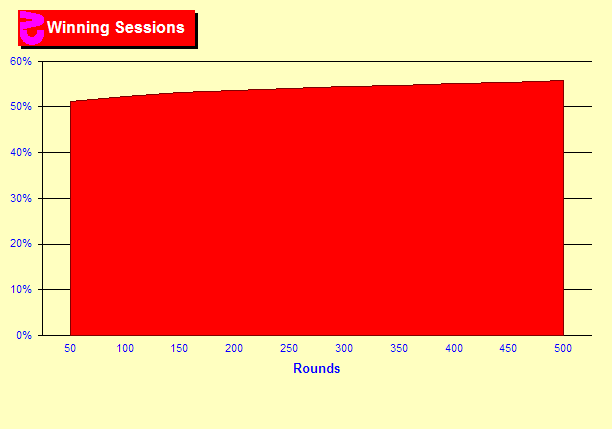Blackjack Hourly Win Rate
For an in-depth description, see Blackjack Attack by Don Schlesinger. For the purposes of this discussion, SCORE directly relates to your hourly win rate. The chart at the right shows the SCORE for the same game as the previous chart. That is, how much we can expect to win at each penetration. Blackjack payout is the easiest to calculate because you only have to multiply the base value times the amount of your bet. The total blackjack payout, then, partially depends on your wager. 3:2 is the payoff for a blackjack. To win the blackjack payout of 3:2, your hand must consist an Ace and a face-card or a ten card.
- Blackjack Hourly Win Rate Calculator
- Blackjack Hourly Win Rates
- Blackjack Hourly Win Rate Today
- Blackjack Hourly Win Rate Predictions
- Appendices
- Miscellaneous
- External Links
Negative Swings
Over the years I have come across very talented card counters, all of who practiced extensively. Despite these steps they are still unsuccessful players. So the question is why is this? The short answer is that when even the most prepared player doesn't understand the statistics variance they don't size their bet properly to their bankroll. Often times over betting their bankroll. As expected this leads to disastrous results. Here we will go over a few things to consider when determining a blackjack betting strategy. A player can then test their strategies at the 888casino's blackjack page. The statistical swings in blackjack are pretty wide; losing periods can extend beyond what a typical player would consider reasonable, so testing strategy is a necessity.
When playing for any length of time, it is certain that they will experience extended periods of heavy losses. Many will get overly discouraged and leave the business all together. To give you an idea of the variance involved if a player were to play a game where they would have a 2% advantage ( extremely optimistic) over the casino, after 2,500 hands of play there is a 20% chance of you being negative.
In real world examples I was once playing solo and after one week of play and 1,600 hands I was down $15,000. The following week I made $16,000 in 1,200 hands. The swings can be pretty violent so it's vital that you have enough of a bankroll to withstand the negative ones.
Earnings Versus Risk
There is a trade off in risk versus earnings for a static bankroll. Consider two players A and B. Player A decides to bet from $1 to $10 dollars. The chance of Player A losing $10,000 is very low. The actual odds are somewhere in the neighborhood of 1 in 2000. The win rate is approximately $6 per hour.
Player B is a very aggressive player and bets from $100 to $1000. The approximate likely hood of Player B going broke is about 4 in 10 (a winning player never has more than a 50% risk of ruin). However, the win rate for Player B is around $600 per hour. The player or team must determine their threshold for earning versus risk.
3% and 5% Elements of Ruin
Aggressiveness varies between teams. The MIT Blackjack Teams played to a 2-3% Risk of ruin and some of the more aggressive teams like the legendary Al Francesco. Big Player teams played to a 5% risk or ruin. This gives the player a failure rate of 1 chance in 20. A common method for teams is to reduce the unit size by 50% when the bankroll has been halved. With this approach the player sets their risk of ruin to 1 chance in 300.
Earning Expectations
Several of the most respected casino gaming authors have estimated the earning expectations of professional counters to be at least 3%. But through my own playing and conversations with other player's (which easily includes a million hands), we have concluded that a win rate of 1.5% over the long term is a reasonable expectations.
Blackjack Hourly Win Rate Calculator
There are a few reasons for the disparity. The first is that many of the authors use computer simulations as a basis for their assertions. No player can play as accurate as a computer; they are bound to make periodic errors. There are several on the fly calculations that the player has to make. Keeping track of cards, adjusting for ace rich or ace poor decks and true count conversions are some of those calculations. This also has to be done with the pit bosses lurking and making the player nervous. With all this to consider, errors are just part of the game. All players make errors, the really good ones make very few.
Even when playing perfectly, it is still not possible to execute the right play. You have to occasionally lay cover plays and some strategy moves have to be avoided because they draw to much attention. For instance splitting 10s is an instant attention getter from the pit.
Lastly, some dealers do cheat. One casino in particular in downtown Las Vegas has a deep reputation for cheating. I don't think that this is a big enough problem to lower the counters edge.
These are a few things the player has to consider when determining their betting strategy. Each strategy is different and the great players are able to mix and match some of the few main pieces and coming up with a few of their original ideas. When the right balance is reached it can be a very profitable endeavor.
Written by: Dustin Jermalowicz
Video poker games can have different payouts from one machine to another, even within the same casino. For example, Double Bonus Poker may pay 8, 9 or 10 per coin on a full house, or 5, 6 or 7 on a flush. It is up to the casino to set the video poker payouts.
The same can be said of table games. Blackjack returns vary based on if a natural is paid 3:2 or 6:5. It can also differ on other rules, such as the dealer hitting or standing on soft 17, and whether there is double down after splitting or surrender. Roulette payouts get worse as zeros are added to the wheel.
The information below shows how much a player can expect to lose playing bad video poker and table games when compared to better rules. I used 600 hands per hour for video poker in the formula. Blackjack is computed at 70 hands an hour. Roulette is based on 50 spins per hour.
Blackjack hourly losses based on rules
Blackjack is the most popular table game. The rules of the game affect the house edge. Below is the difference in theoretical loss between 3:2 and 6:5 tables based on 70 hands per hour. The dollar amount shown implies the average bet during the hour.
3:2 versus 6:5 payout
The difference in house edge between a 3:2 and 6:5 game with the same rules is 1.39 percent. A player will receive about 3.5 blackjacks per hour at a table. Below is a list of the expected loss when playing at a 6:5 table as opposed to a 3:2 one. It equates to about one bet per hour.
- $5: $4.87/hr
- $10: $9.73/hr
- $15: $14.60/hr
- $25: $24.33/hr
Double zero roulette versus triple zero roulette
Triple zero roulette is spread at more than a dozen Las Vegas casinos. The house edge jumps from 5.26 percent to 7.69 percent when the additional zero is on the wheel, for a difference of 2.43 percent. The theoretical loss at a triple zero roulette game when compared to double zero is shown below:
- $5: $6.08/hr
- $10: $12.16/hr
- $15: $18.23/hr
- $25: $30.38/hr
Single zero roulette versus double zero

The house edge for single zero roulette is 2.7 percent, for a difference of 2.56 percent when compared to double zero roulette. The lowest limit for single zero roulette in Las Vegas is $25. The list below shows several limits and the effect on the player’s return.
Blackjack Hourly Win Rates
- $25: $32/hr
- $50: $64/hr
- $100: $128/hr
Video poker
Video poker payouts can differ substantially from one casino to another and from bank-to-bank within one. It is important to find the best pay table in a casino. VPFree2 is a great resource for this information.

The payout on a video poker game that does not have wild cards drops about one percent for each coin drop in the pay table for a flush or full house. Combining that with the quick rate of play of about 600 hands per hour, and you see how quickly that can add up.
Double Double Bonus
One of the most popular video poker games is Double Double Bonus. The best pay table for it in a casino is generally 9/6, meaning nine coins are won for each one bet on a full house and six for a flush. This returns 98.98 percent to players with perfect play and five coins wagered. The $1.25 represents the typical max bet on the quarter denomination. The $2.50 is half-dollar, while $5 is the $1 denomination.
Some casinos drop the payout to 9/5, 8/5, and in some cases, 7/5. This list below compares each of these payouts to 9/6 Double Double Bonus.
9/5 Double Double Bonus
- $1.25 bet: $8.32/hr
- $2.50: $16.65/hr
- $5: $33.30/hr
8/5 Double Double Bonus
Blackjack Hourly Win Rate Today
- $1.25: $16.49/hr
- $2.50: $32.85/hr
- $5: $65.70/hr
7/5 Double Double Bonus
- $1.25: $24.53/hr
- $2.50: $49.05/hr
- $5: $98.10/hr
Double Bonus Poker
The best pay table for Double Bonus Poker is often 9/7/5. This means a full house pays nine coins for each one wagered, while a flush pays seven and a straight returns five. This game returns 99.11 percent with five coins bet and perfect play. Some casinos drop these returns to 9/6/5, 9/6/4, 9/5/4, and in come cases, 8/5/4. The list below shows the expected loss when playing one of these pay tables as opposed to the 9/7/5 version.
9/6/5 Double Bonus
- $1.25: $9.75/hr
- $2.50: $19.50/hr
- $5: $39/hr
9/6/4 Double Bonus
- $1.25: $20.48/hr
- $2.50: $40.95/hr
- $5: $81.90/hr
9/5/4 Double Bonus

- $1.25: $28.80/hr
- $2.50: $57.60/hr
- $5: $115.20/hr
8/5 Double Bonus
- $1.25: $36.90/hr
- $2.50: $73.80/hr
- $5: $147.60/hr
Blackjack Hourly Win Rate Predictions
Bonus Poker
The best pay table for Bonus Poker in Las Vegas is typically 8/5. This returns 99.17 percent. Below is the difference between playing this game and 7/5 and 6/5 payouts for a full house and flush, respectively.
7/5 Bonus Poker
- $1.25: $8.76/hr
- $2.50: $17.40/hr
- $5: $34.80/hr
6/5 Bonus Poker
- $1.25: $17.25/hr
- $2.50: $34.50/hr
- $5: $69/hr